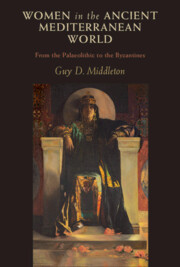Book contents
- Women in the Ancient Mediterranean World
- Women in the Ancient Mediterranean World
- Copyright page
- Dedication
- Epigraph
- Contents
- Preface
- Acknowledgements
- Timeline
- Historical Contexts
- Introduction
- Part I The Deep Past
- Part II The Bronze Age
- Part III The Iron Age
- Part IV The Hellenistic Worlds
- 20 Olympias
- 21 Seianti Hanunia Tlesnasa
- 22 Terentia
- 23 Mariamne
- Part V The Age of Empire
- Notes
- Select Bibliography
- Index
20 - Olympias
from Part IV - The Hellenistic Worlds
Published online by Cambridge University Press: 19 January 2023
- Women in the Ancient Mediterranean World
- Women in the Ancient Mediterranean World
- Copyright page
- Dedication
- Epigraph
- Contents
- Preface
- Acknowledgements
- Timeline
- Historical Contexts
- Introduction
- Part I The Deep Past
- Part II The Bronze Age
- Part III The Iron Age
- Part IV The Hellenistic Worlds
- 20 Olympias
- 21 Seianti Hanunia Tlesnasa
- 22 Terentia
- 23 Mariamne
- Part V The Age of Empire
- Notes
- Select Bibliography
- Index
Summary
Olympias, born around 373 bc, was the daughter of Neoptolemus the king of Molossia, a rural, inland, and not-so-important place in Epirus in north-western Greece. The region lacked the old established city-state culture of other parts of Greece, but the oracle of Zeus at Dodona, by tradition the oldest oracle in Greece, did give it some cachet and ensured ongoing contact with the rest of the Hellenic world.1 The royal house, the Aeacids, claimed descent from the Greek hero Aeacus and from his more famous grandson Achilles – a family connection that Olympias’ son Alexander (the Great) certainly took seriously.2 Despite her origins on the periphery of the Greek world, Olympias occupied a central place in the history of the Aegean and eastern Mediterranean – and farther afield – in the second half of the fourth century bc because of her marriage to Philip II of Macedonia and her son Alexander the Great.
- Type
- Chapter
- Information
- Women in the Ancient Mediterranean WorldFrom the Palaeolithic to the Byzantines, pp. 165 - 171Publisher: Cambridge University PressPrint publication year: 2023

